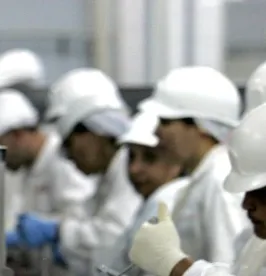Recently, the United States General Accounting Office (GAO), which is a nonpartisan agency in the legislative branch, took on oversight of the executive branch agency, Occupational Safety and Health Administration (OSHA). In this case, the GAO is making recommendations that OSHA take actions to protect meat and poultry workers from COVID-19 (though the actual recommendations relate to infectious diseases as a whole).
Quick Hits
-
The GAO is recommending that OSHA assess actions, such as an industry standard, to protect meat and poultry workers from infectious diseases.
-
The GAO also recommended that OSHA improve collaboration with the U.S. Department of Agriculture.
-
The Supreme Court’s January 2022 stay of OSHA’s COVID-19 ETS leaves room for the agency to work on a standard to prevent the spread of infectious diseases in the workplace.
In its June 20, 2023, report, GAO-23-105104, “Meat and Poultry Worker Safety: OSHA Should Determine How to Address Persistent Hazards Exacerbated by COVID-19,” the GAO recommended that OSHA “assess the actions needed to protect” employees in the meat and poultry processing industries against infectious diseases. The GAO noted a “sharp[] increase” in the rates of injuries and illnesses among employees in these industries early in the pandemic, and that “studies, federal inspections, and worker interviews suggest that meat and poultry workers continued to face high risk of infection in the first year of the pandemic.” (The GAO does not make reference to the number of reports between February 2020, and June 2022, but reported that in one facility, the rate of infection was seventy times greater than in the rest of the community.) The GAO attributed this increase to three items:
-
OSHA lacks a standard targeting COVID-19–related hazards, which allowed employers to continue requiring employees to work in close proximity.
-
Processors’ efforts to protect workers by encouraging social distancing in communal areas, installing barriers between workspaces, and requiring masks were not overly effective.
-
OSHA and the U.S. Department of Agriculture’s (USDA) Food Safety and Inspection Service (FSIS) failed to follow “[l]eading collaboration practices” and that there was little field-level communication between OSHA and FSIS staff.
However, the GAO noted that OSHA and the FSIS acted in August 2022 to increase collaboration by updating a 1994 memorandum of understanding to provide that that FSIS will report hazards to OSHA, including infectious diseases. Addressing the first item, GAO encouraged OSHA to assess the need for an infectious disease standard in the meat and processing industries because employees work in such close proximity.
GAO offered three recommendations to the executive branch, two to the U.S. Department of Labor (DOL), and the other to the USDA:
The Secretary of the Department of Labor should ensure that OSHA assesses and reports on which actions—such as an industry-specific standard—are needed to protect meat and poultry workers from the numerous hazards they face, including the risk of infectious disease. OSHA could decide to request assistance from CDC’s [U.S. Centers for Disease Control and Prevention] NIOSH [National Institute for Occupational Safety and Health] in this process. (Recommendation 1)
The Secretary of the Department of Agriculture should ensure that the FSIS meets regularly with OSHA through their interagency workgroup to resolve longstanding collaboration challenges and incorporate leading collaboration practices. In incorporating these practices, the agencies should clearly define short and long-term outcomes, track and monitor progress towards these outcomes, and publicly report collaborative outcomes. (Recommendation 2)
The Secretary of the Department of Labor should ensure that OSHA meets regularly with USDA’s FSIS through their interagency workgroup to resolve longstanding collaboration challenges and incorporate leading collaboration practices. In incorporating these practices, the agencies should clearly define short- and long-term outcomes, track and monitor progress towards these outcomes, and publicly report collaborative outcomes. (Recommendation 3)
The report prompts several questions for observers of workplace safety and health in the meat and poultry industry. The first question is whether OSHA will accept the invitation. Notably, the backlash to its COVID-19 emergency temporary standard (ETS) was immediate and overwhelming. OSHA may decide to wait until an infectious disease pandemic arises. A second question is: If OSHA accepts the invitation, how far will OSHA reach? The meat and poultry processing industries are not the only industries in which employees work in close proximity. Manufacturing assembly-line workers is but one example of an industry where employees work in close proximity to each other. How broadly will OSHA define a “close proximity” hazard?
A third question is whether a “close proximity” standard for infectious diseases can withstand challenge. The Supreme Court of the United States’ January 2022 decision in the stay of OSHA’s enforcement of the COVID-19 ETS indicates an infectious disease standard governing “close proximity” work environments is within OSHA’s authority.
In January 2022, the Supreme Court stayed OSHA’s enforcement of the agency’s COVID-19 ETS, stating that OSHA has the authority to “set workplace safety standards, not broad public health measures,” and “although COVID-19 is a risk that occurs in many workplaces, it is not an occupational hazard in most….” (Emphasis in the original.) However, the Court’s holding did not prohibit OSHA from regulating the hazards of COVID-19 on a more restrictive basis:
That is not to say OSHA lacks authority to regulate occupation-specific risks related to COVID–19. Where the virus poses a special danger because of the particular features of an employee’s job or workplace, targeted regulations are plainly permissible. We do not doubt, for example, that OSHA could regulate researchers who work with the COVID–19 virus. So too could OSHA regulate risks associated with working in particularly crowded or cramped environments.
Currently, OSHA is grappling with a proposed regulation of infectious diseases in the healthcare and other “high-risk” industries. OSHA has the tacit approval of the Supreme Court to go beyond the healthcare industry and has been invited by the GAO to do so. “Close proximity” regulation is not on OSHA’s current agenda. But it would not be surprising to see it on a future agenda, or as the basis of an ETS should the United States face another infectious disease pandemic.




 />i
/>i
